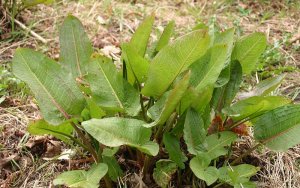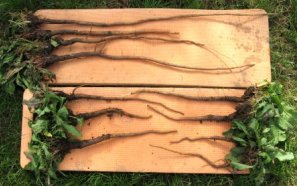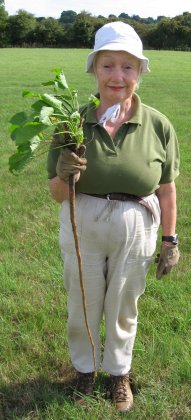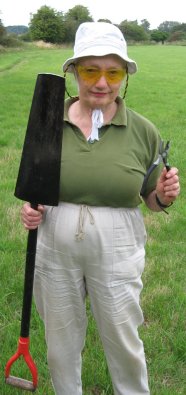Updated 11 Aug 2011
|
How to pull docks
|
|
Dock weeds keep growing until most of their taproot is removed
|
Broad-leafed docks live up to their name
 |
Docks have unusually long taproots (up to 1 metre)
 |
DOCKS (Broad-leafed dock)
Rumex obtusifolius.
"Rumex obtusifolius is easily recognizable by its very large leaves,
some
of the lower leaves having red stems. The edges of the leaves are slightly
"crisped" or wavy. The foliage of the plant can grow to about 18 inches
in height. The stems have nodes covered by an ocrea, a thin, paper-like
membrane - a characteristic of the Polygonaceae family.
Large clusters of racemes contain green flowers that change to red as they
mature. They are held on a single stalk that grows above the leaves and
blooms June through September. The seeds produced are reddish-brown.
Seedlings can be identified by the oval leaves with red stems and rolled
leaves sprouting from the center of the plant."
Wikipedia
|
The best way
to eradicate
Docks is to "pull" the root, using a ditch spade.
Cut all round the dock to the full depth of the blade. Pull the blade
half out, then carefully lever the rootball. A strong blade is needed
to handle the bending force required. Usually the taproot is heard to
snap. By hand, lift the rootball out, exposing (with luck) most of the
taproot in the rootball. Break the rootball by hand, extract all of the
plant and root,
dispose of safely (preferably by burning). Explore the cavity by hand,
pull out any remnants of root using a long-nosed locking wrench.
Fill the cavity with earth from the rootball, and stamp down.
|
Broad-leaf dock with 92 cm taproot.
Root fragments may grow again.

|
"Broadleaf dock is considered a weed and is slightly poisonous. It is
designated an "injurious weed" under the UK Weeds Act 1959. Livestock
have been known to get sick after feeding on it. But eradicating the
plants is difficult. The perennial plant can have a deep taproot reaching
5 feet down.
Also, the milk of the plant has been known to cause mild dermatitis.
Seeds have toothed wing structures, allowing them to be dispersed by wind
or water, and also allow them to attach to animals or machinery to be
spread great distances. They can
lie dormant for years before germination,
making vigilant pulling or tilling essential.
First year plants can seed, making early detection important for eradication.
The main weaknesses of Broadleaf are its poor competition, crowding causes
flowering to be delayed for up to three years, and its susceptibility to
disturbance. Frequent tilling will disrupt roots and kill seedlings and
even older plants. The plant also thrives in moist environments and
improved drainage can also help control its growth."
Wikipedia
|
Ditch spade: metal blade + shaft.
Strength to lever out the rootball.

|
Compiled, formatted, hyperlinked, encoded,
and copyright © 2011, John Palmer,  All Rights Reserved. All Rights Reserved.
|